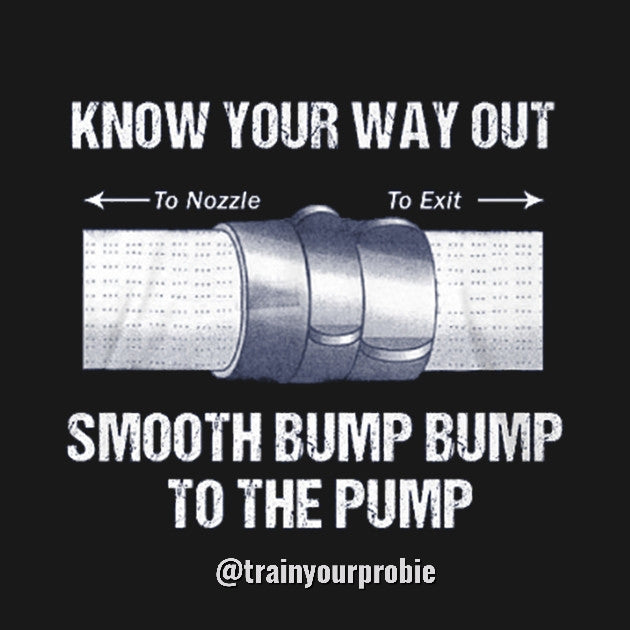
Smooth, Bump Bump, To The Pump
YOU ARE OPERATING INSIDE A fire building when suddenly you discover that you are lost, disoriented, and separated from your crew. As you attempt to locate a wall or a window, you come in contact with a hoseline. Which way is out? If you locate the coupling, you can determine which direction leads to the exit. Or can you?
The procedure for following the hoseline to safety in Essentials of Fire Fighting states, “Follow the hoseline out if possible (the male coupling is the closest to the exit; the female is the closest to the fire).”1
Yet time and again during training, when firefighters find the hoseline and follow it to the coupling, they become hesitant and indecisive: Which coupling leads out? I have seen firefighters attempt to uncouple a hoseline to determine which coupling has the swivel. I have seen too many firefighters turn toward the fire and wind up at the nozzle when they could have been out of the building had they gone in the opposite direction. When members are questioned about the problems encountered at the coupling, many times the response is that they just didn’t remember or fully understand the way it was explained in the text.
 1. Photos by author. |
If the firefighter does remember to follow the male coupling out, there may still be confusion once the coupling is located. If the firefighter is at the midpoint of the hose between couplings, the first coupling he will encounter on the way toward the exit will be the female. The firefighter understood that he was to follow the male end to the exit, so that firefighter turns in the other direction and heads toward the male end, toward the fire. Many have stated that they have a good grasp of the concept until their face piece is obscured.
 2. |
Here’s a simple memory aid I learned and have shared that seems to have helped firefighters remember the proper direction toward the exit: Bumps to the pumps. If the firefighter finds the hoseline and follows it to the coupling, the bumps (lugs) lead to the pumps (engine on the exterior) (photos 1, 2). It’s easy to remember and understand and reduces or eliminates the confusion and hesitation at the coupling. When a firefighter is low on air, disoriented and alone, the time spent at the coupling may be more time than he can afford to be able to get out safely. It also reduces the anxiety of being unable to determine the proper way out. This translates into better air management for the firefighter in distress.
Of course, this method is not a cure-all for every situation and every circumstance. It works best with threaded couplings that have rocker lugs. The male coupling has lugs on the shank. The female coupling has a smooth shank with lugs on the swivel (photo 3). The firefighter can feel the rocker lugs with a gloved hand under zero visibility conditions and determine the proper direction to the exit.
 3. |
Some may ask about a situation in which the hose is advanced into a structure with the female end first. If this is the situation, the firefighter will have to identify this situation prior to entering the building. Some departments may use attack hose with storz-type couplings. In this situation, there will be no male or female couplings (photo 4). In this case, it will be difficult to determine the direction of the exit. However, devices that indicate the way toward the exit are commercially available. For example, one such device that can be slipped over a hose has a raised arrow marking a firefighter can feel to determine the direction of the exit. This may be a good alternative for your situation.
 4. |
A quick drill on this technique involves using a single length of hose and a firefighter wearing gloves. Connect the couplings to create a continuous loop (photo 5). Place the firefighter at the midpoint of the hoseline, and have him follow the hose to the coupling. When the member reaches the coupling, ask him to determine, without looking at the coupling, whether he is headed in the direction of the exit.
 5. |
As with all other firefighter survival techniques, this method needs to be practiced to develop and maintain a high level of proficiency. A thorough knowledge of your department’s equipment and procedures is important. Being familiar with any mutual-aid department’s equipment is equally important.
• • •
Perhaps you have heard of this method before. Perhaps you do not like it or feel more comfortable with your own. I’ve found that this works for me and has helped those who have had problems during training evolutions. What is most important is that if things go wrong, you are able to determine which way is out. ■
Endnote
1. Essentials of Fire Fighting, fourth edition. Stillwater, OK: Fire Protection Publications, 1998, 108.
ABOUT THE AUTHOR- ■ MICHAEL ALLORA is a lieutenant and a 10-year veteran with the Clifton (NJ) Fire Department. He is a Level 2 fire instructor at the Passaic and Sussex counties’ public safety academies. Allora has an associate’s degree in fire science from Passaic County Community College.
ORIGINAL POST: http://www.fireengineering.com/articles/print/volume-159/issue-2/departments/training-notebook/following-hose-couplings.html
